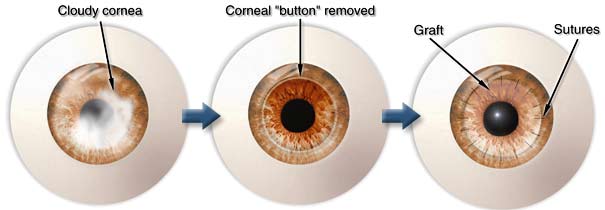Corneal transplantation
Task of the cornea - fibred, transparent front part of the eye that covers optical systems of the eye - is to protect eyes from mechanical damages and infections. Similarly as task of the wrist watch is to protect a clock-face. When glass breaks, it needs to be changed. Unfortunately also corneal is not immune from damages. Most often damages are caused by keratitis that is the inflammation of the corneal of the eye and cause of ulcers. Due to keratitis corneal is becoming hazy and haziness increases with the cicatrisation to such extent that it does not let light to pass through. Also ulcers can damage corneal to such extent that it needs to be replaced. With the so-called "emergency method" doctors try to perform application of contact lenses but it does not always help. Also genetically determined progressive dystrophy of tissues can be encountered pretty often but in these cases the sick corneal usually can't be cured with medications and then corneal transplantation is required. Corneal can become hazy also after cataract or other eye surgeries, especially, if the tissues of the patient's eye turned out to be fragile and not solid. The hazier the cataract is, the greater is the risk that corneal can suffer due to surgery.
It is known from the history that transplantation of corneal was the first successful transplantation in the world. In Latvia first corneal transplantation was performed in 1934 by the professor Kārlis Balodis.
Also ophthalmic doctors have made sure about the high demand for the corneal transplantations.
Now our clinic provides possibility to perform two methods of corneal transplantations - the full corneal transplantation that is known for a long-time and widely used around the world (during this procedure all five layers of the corneal are transplanted, without separating them), or the new method - keratoplasty of the inner part of corneal DMEK that is the Descement's Membrane Endothelial Keratoplasty. DMEK is used if the inner layer of corneal is damaged. It should be pointed out that its density is four microns (for comparison - density of the central part of corneal is from 450 to 600 microns). DMEK is a new achievement in the world; in 1998 Director of the Innovative Eye Surgery Institute of Netherlands, Dr. Gerrit Melles implemented this method, although since 1950 there were attempts to discover a method that does not require full transplantation of the corneal.
DMEK surgery had very good results, also rehabilitation period of the patient were much shorter than after the full transplantation of the corneal when, for example, stitches can be removed only year after surgery. After DMEK there are no stitches at all, also structure of the eye is not altered and improvement can be observed already within a week. As the optical system of the eye is not affected during this surgery, then the short-sightedness or farsightedness of the person remains the same. It is important to note that when only membrane is transplanted (DMEK), it is usually not rejected. Surgery is performed under local anaesthesia and lasts approximately an hour. If at the same time patient undergoes also cataract surgery, then it lasts longer.
Necessary transplants are provided in cooperation with the live tissue bank in the United States of America.





